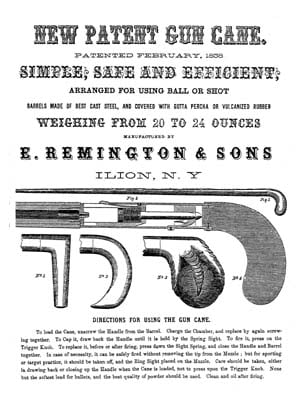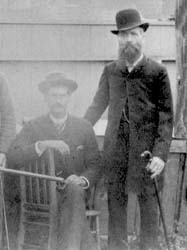
Cane guns were popular in America in the
mid-1850s. They served as protection, as well as being
a gentleman’s walking accessory. Never intended to be
formidable weapons, cane guns protected their owners
against stray dogs and the occasional advances of
ruffians.
Eliphalet Remington, founder of E. Remington &
Sons, was on the lookout for products for the civilian
trade, and he had to look no further than a cane gun
designed by John F. Thomas, an employee at his factory,
who had previously been a gunsmith in Ilion. On
February 9, 1858, Thomas, who later came to be master
mechanic at E. Remington & Sons Armory, was issued
U.S. Patent #19,328 for his percussion cane gun. Thomas
assigned half of his invention to Samuel Remington in
July 1859, and production is believed to have commenced
sometime that year.
Not only was this cane gun one of the first civilian
firearms made by E. Remington & Armory, the firm
was the only major gunmaker ever to offer a cane gun.
Production was interrupted during the Civil War years
(1861 to 1865), and probably resumed in mid-1865.

At first, only .31 caliber percussion cane guns were
manufactured and sold by Remington. Pre-Civil War
advertising refers to them as “Remington’s New Patent
Gun Canes, which were loaded with a .31 caliber lead
ball”. Another variation was listed in early E.
Remington & Sons advertisements with longer
internal barrel — it was intended for shot
pellets.
Serial numbers of the gun canes went from 1 to over
278. The iron, rifled barrel within the longer cane
shaft measures only about 9 inches. Thereafter, the
bullet traveled loosely through a brass tube to the
muzzle, which was plugged for walking.
Remington (Thomas Patent) cane guns were made with a
variety of handles, including ball & claw, dog’s
head (two sizes), full curve, curve with flat gripping
area, bulbous-shape, and L-shape. The Remington rifle
cane shaft was covered with a hard rubber gutta-percha
(a very fragile molded material that cracked easily) or
vulcanized rubber. In the 1870s, ivory handles were
offered. A unique gold-plated brass dog head cane is
known, in .22 caliber rimfire, and bears an inscription
date of 1876.

Various colors of the canes were available, including
black, brown and coral. While coral sounds interesting
in the advertisement, an examination of an actual
specimen in the Remington museum collection, and
another owned by RSA member Mike Strietbeck, reveals
“coral” to actually be a bright orange color. Many
different handle, barrel, shaft and overall lengths
(33½” to 36½” known) were made.
In the late 1860s, Remington’s cane gun was
re-designed to handle .22 caliber rimfire ammunition
(called the Remington No. 1 Rifle Cane) and .32 caliber
rimfire (Remington No. 2 Rifle Cane).Remington’s
rimfire cane guns were first made with internal
hammers, but were later improved with a rod driving the
firing pin.
Serial numbers for rimfire cane guns started at 1 and
went to over 1748. Production probably ceased in 1886,
when times were hard for E. Remington & Sons. The
new proprietors, who named the company Remington Arms
Company in 1888, saw no reason to resume production of
cane guns. As it was, not many Remington’s percussion
and rimfire (Thomas Patent) cane guns were made — and
fewer than 2,000 were produced over a 27-year period.
Today, they are highly prized by
collectors.
